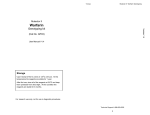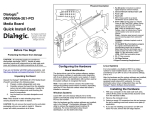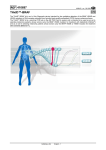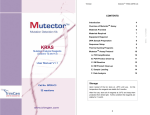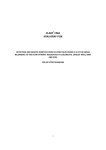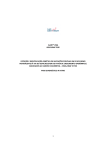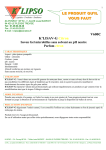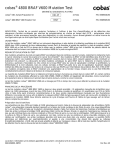Download User Manual V1.6
Transcript
BRAF V600 mutation detection kit (GP02-EK) User Manual V1.6 MutectorTM II BRAF V600 Mutation Detection Kit Cat No. GP02-EK User Manual V1.6 . eQ-705LC For research use only, not for use in diagnostic procedures 1 BRAF V600 mutation detection kit (GP02-EK) User Manual V1.6 Limited Product Warranty It is imperative that the users strictly adhere to this manual. Failure to do so will void TrimGen's guarantee of this product. TrimGen Corporation makes no other warranties of any kind, expressed or implied, including without limitation, warranties of merchantability or fitness for a particular purpose. Notice to Purchaser The MutectorTM II kit is provided as research use only, not for use in diagnostic procedures. The purchaser must determine the suitability of the product for their particular use. The purchase of the MutectorTM II kit includes a limited, nonexclusive license to use the kit. This license does not grant rights to reproduce or modify the MutectorTM II kit for resale, or to use the MutectorTM II kit to manufacture commercial products without written approval of TrimGen Corporation. No other license, expressed, implied or by estoppels is granted. Product Safety and Liabilities When working with the kit reagents, always wear a lab coat, disposable gloves and protective goggles. TrimGen Corporation shall not be liable for any direct, indirect, consequential or incidental damages arising out of the misuse, the results of use, or the inability to use this product. 2 BRAF V600 mutation detection kit (GP02-EK) User Manual V1.6 CONTENTS Introduction 4 Overview of MutectorTM II Assay 5 Materials Provided 6 Materials Required 7 Equipment Required 7 DNA Sample Preparation 8 Sequencer Setup 8 Thermal Cycling Programs 9 MutectorTM II Assay Protocol 10 Data Analysis 15 Troubleshooting 16 Storage Upon receipt of the kit, store at –20oC until use. At this temperature the reagents are stable for 8 months. After first use, store all of the reagents at 2-8oC and keep them protected from direct light. At this condition the reagents are stable for 2 months. 3 BRAF V600 mutation detection kit (GP02-EK) User Manual V1.6 Introduction The MutectorTM II BRAF V600 mutation detection kit (GP02-EK) uses TrimGen’s proprietary technology called Shifted Termination Assay (STA) to detect mutations in codon V600 of the BRAF gene. This single tube assay detects the following mutations: V600E (GTG>GAG) V600A (GTG>GCG) V600G (GTG>GGG) V600K (GTG>AAG) V600R (GTG>AGG) The STA technology enriches mutation signals and is able to detect low levels of somatic mutations. MutectorTM II has sequencing-like accuracy through multiple steps: (1) PCR amplification, (2) Selective sequence hybridization, (3) Sequence dependent termination and specific primer extension by STA. * Shifted Termination Assay (STA) Shifted Termination Assay (STA) technology is a proprietary multi-base primer extension method. The specially formulated ST reagents extend detection primers by multiple bases to increase signal strength and fragment size, creating mutation peaks that are easily distinguished from wild type. The STA technology has sequencing like accuracy and the mutation is confirmed by both peak color and fragment size. The method enriches mutation signal and detects low-level mutations missed by sequencing. Mutant Wild type Mutant x Wild type x Fragment analysis STA reaction 4 BRAF V600 mutation detection kit (GP02-EK) User Manual V1.6 Overview of MutectorTM II Assay Single tube assay for each sample PCR amplification Step 1 1-2 hours* * Time varies depending on the type of thermal cycler used Step 2 C-UP treatment (PCR product clean-up) 30 min ST reaction Step 3 Mutation enrichment and detection 45 min* * Time varies depending on the type of thermal cycler used Load to sequencer Step 4 Wild type Capillary Electrophoresis Fragment analysis 30 min Mutation 5 BRAF V600 mutation detection kit (GP02-EK) User Manual V1.6 Materials Provided: The MutectorTM II BRAF Mutation kit (GP02-EK) contains reagents for 32 reactions. Materials Quantity Master Mix 650 μL PCR-P 50 μL C-UP1 40 μL C-UP2 40 μL C-UP Buffer 350 μL ST-BF* 400 μL DP-BF 80 μL CTL-BF 50 μL Loading Buffer* 650 μL TF - Filters 32 Collection Tubes 32 x 2 * Light sensitive: Keep these reagents protected from direct light. Reagents Description: Master Mix Reagents for DNA amplification. PCR-P PCR primer mix for amplification of BRAF gene. C-UP1 and C-UP2 Enzyme mix for cleanup of PCR products. C-UP Buffer Buffer for the C-UP enzymes. ST-BF (Light sensitive) Pre-mixed reagents for mutation enrichment and detection. DP-BF Pre-mixed detection primers. 6 BRAF V600 mutation detection kit (GP02-EK) User Manual V1.6 CTL-BF Pre-mixed mutant and wild type DNA. The controls are sufficient for 16 test runs. Loading Buffer (Light sensitive) Loading buffer for ABI capillary type sequencers and special fluorescence-labeled size standards. Materials required: 0.2 ml PCR tubes (8-well strip tube) DS-32 Matrix Standard Kit for the 3100 and 3130 Series Systems (one time set up. Applied Biosystems Cat. No. 4345831) Equipment required: Thermal Cycler: Any type of thermal cycler with a 0.2 ml tube block is acceptable for performing the MutectorTM II assay. Sequencer: Applied Biosystems capillary type Genetic/DNA Analyzer Analysis Software: Data Collection® software for ABI capillary sequencer GeneMapper® for fragment analysis or GeneScan® 7 BRAF V600 mutation detection kit (GP02-EK) User Manual V1.6 DNA Sample Preparation: Any commercially available DNA extraction kit is acceptable. Paraffin (FFPE) tissue samples A high efficiency DNA extraction kit for FFPE sample is available from TrimGen. Product information: WaxFreeTM DNA for 50 samples (Cat. # WF-50) WaxFreeTM DNA for 100 samples (Cat. # WF-100) DNA concentration: When using a column or bead DNA extraction method, adjust the final concentration of extracted DNA to 20-80 ng/ μL. When using TrimGen’s DNA preparation kit, follow the kit protocol to perform the PCR reaction. Sequencer setup: First time users should set up the analysis program for the sequencer (one time setup). After setup, the program can apply to all Mutector™ II tests for data analysis. Please choose either GeneMapper® or GeneScan® to analyze your data. GeneMapper® Analysis Step I. GeneMapper® Setup www.trimgen.com/docs/PartI-GeneMapper-Setup.pdf Step II. Data Collection® Software Setup www.trimgen.com/docs/PartII-Data-Collection-Setup.pdf Step III. Data Analysis Using GeneMapper® www.trimgen.com/docs/PartIII-Data-Analysis-GeneMapper.pdf GeneScan® Analysis Step I. Data Collection® Software Setup www.trimgen.com/docs/PartII-Data-Collection-Setup.pdf Step II. GeneScan® Setup and Data Analysis www.trimgen.com/docs/PartIV-Genescan.pdf 8 BRAF V600 mutation detection kit (GP02-EK) User Manual V1.6 Important Spectral calibration is required before running the test To read the test results correctly, the sequencer needs to be calibrated with the DS-32 calibration kit (Applied Biosystems Cat. No. 4345831). This is a one-time calibration to set up correct spectral channels to read the test results. Refer to the DS-32 Matrix standards kit to prepare the DS-32 matrix standards. Run a Matrix Standard Set DS-32 (5FAM, JOE, NED, ROX) to perform a spectral calibration. Thermal Cycling Programs: Program 1 (PCR) 1 cycle 94oC 5 min 35 cycles 94oC 30 sec 52oC 30 sec 72oC 30 sec 1 cycle 72oC 5 min Hold at 4oC Program 2 (PCR product clean up) 37oC 25 min 95oC 5 min Hold at 4oC Program 3 (ST reaction) 1 cycle 94oC 4 minute 20 cycles 94oC 20 sec 55oC 30 sec 72oC 20 sec Hold at 4oC 9 BRAF V600 mutation detection kit (GP02-EK) User Manual V1.6 MutectorTM II Assay Protocol: A. PCR Amplification Thaw all reagents and keep on ice. Spin down the reagents before use. Mutation controls (CTL-BF) are required for each test run. A negative control (water) is suggested to run with the samples each time. A.1. Collect 0.2 ml PCR strip tubes and label the tubes as follows: Sample 1, 2, 3 …… Neg Pos 1 3 2 4 5 Neg: Negative control (water) Pos: Positive control (CTL-BF) A.2. Prepare PCR reaction mix: + 2*) x 1.1** = Master Mix = 18 x ( μL Total number of sample + 2*) x 1.1** = PCR Primers = 1 x ( μL Total number of sample *For negative and positive controls. ** For pipetting error. Transfer entire volume of the reagents to one tube and mix the contents. This is the PCR reaction mix. A.3. Add 19 μL of PCR reaction mix into each tubes. A.4. Add 1 μL of nuclease-free water to the “Neg” tube. A.5. Add 1 μL of CTL-BF to the “Pos” tube. A.6. Add 1 μL of sample DNA (20-80 ng/l) to each sample tube. 10 BRAF V600 mutation detection kit (GP02-EK) User Manual V1.6 A.7. Place the PCR tubes in a thermal cycler and run Program 1. Program 1 94oC 5 min 1 cycle 94oC 30 sec 52oC 30 sec 72oC 30 sec 35 cycles 72oC 5 min 1 cycle Hold at 4oC The procedure can be temporarily stopped after Program 1. The PCR product can be stored at 4oC for next day test. During the PCR amplification, prepare steps B1-B2. B. PCR Product Clean-up Prepare the C-UP mix C-UP1 = 1.0 x number of samples x 1.1* = μL C-UP2 = 1.0 x number of samples x 1.1* = μL C-UP Buffer = 10 x number of samples x 1.1* = μL * For pipetting error. B.1. Collect 0.2ml strip tubes, one tube for each PCR reaction. Label the tubes the same as the PCR tubes. B.2. Add 12 μL of C-UP Mix to each new tube. B.3. Transfer 5 μL of PCR products to each corresponding tube. B.4. Cap the tube, mix the contents and spin all tubes. B.5. Incubate the tubes in a thermal cycler using Program 2. Program 2 37oC for 25 min 95oC for 5 min Hold at 4oC During the incubation, prepare steps C1-C4. 11 BRAF V600 mutation detection kit (GP02-EK) User Manual V1.6 C. ST Reaction (Mutation enrichment) C.1. Collect one 2ml tube and label the tube with “ST”. Prepare ST Mix using formula below: ST Mix ST-BF = 11 x ( + 2*) x 1.1** = μL Total number of sample DP-BF = 2 x ( + 2*) x 1.1** = μL Total number of sample *For negative and positive controls. ** For pipetting error. Transfer entire volume of the reagents to one tube and mix the contents. This is the ST mix. C.2. Collect 0.2ml strip tubes, one for each PCR reaction. Label the tubes with sample ID. Label the tubes as follows: Controls Neg Pos 1 2 3 Samples 1, 2, 3… C.3. Add 13 μL of ST Mix (from step C.1) into each of the tubes. C.4. Add 2 μL of C-UP treated Negative PCR control to the “Neg” tube. C.5. Add 2 μL of C-UP treated Pos to the “Pos” tube. C.6. Add 2 μL of C-UP treated Sample to each corresponding sample tube. C.7. Mix the contents and spin all tubes. 12 BRAF V600 mutation detection kit (GP02-EK) User Manual V1.6 C.8. Place the tubes into the thermal cycler and perform the ST reaction using Program 3. Program 3 1 cycle 94oC 4 min 20 cycles 94oC 20 sec 55oC 30 sec 72oC 20 sec Hold at 4oC D. ST Product Clean-up Filter preparation D.1. Collect the TF - Filters and Collection Tubes (one set for each ST reaction). D.2. Snap off the bottom portion of the filter tip (ref. page 7 for snap off-line). D.3. Centrifuge the TF - Filters at 1,000 x g (3000 rpm for most tabletop centrifuge) for 2-3 minutes to remove the excess liquid from the filters. D.4. Discard the Collection Tubes and move the TF - Filters into a new Collection Tube. Label the Collection Tubes with sample ID. The TF - Filters are ready for use. D.5. After the ST reaction, load all ST reaction contents (15l) onto the top of the gel in each pre-prepared TF - Filter. D.6. Centrifuge the TF - Filters at 1,000 x g (3000 rpm for most tabletop centrifuge) for 2-3 minutes. D.7. Discard the TF - Filters. The solution in the tubes contains ST product and is ready for sample loading. 13 BRAF V600 mutation detection kit (GP02-EK) User Manual V1.6 E. Sample Loading E.1. Add 15 μL of the Loading buffer to each well of a sequencer adapter plate. E.2. Transfer 2-4 μL of the filtered ST products into each well. Signal may vary depending on the instrument used. It is recommended to adjust the loading volume to optimize the signal on your machine. If the signal is too strong, dilute the ST product with water (3-5 times) before loading the sample. E.3. Load the plate to sequencer and run the pre-set Data Collection Program (ref. page 8). F. Data Analysis F1. Open the analysis software GeneMapper or GeneScan F2. Follow the instructions to add the data for analysis. The instructions are provided online: GeneMapper: www.trimgen.com/docs/PartIII-Data-AnalysisGeneMapper.pdf GeneScan: www.trimgen.com/docs/PartIV-Genescan.pdf. F3. In the sample plot window (shows graphic data), zoom in the graphic by selecting area between size markers 25 (the 2nd marker) and 80 (the 6th marker) along the X-axis (see figure 1). F4. Find the results for the mutation controls CTL-BF. F5. The mutation controls CTL-BF will show a total of 5 peaks. Use these controls as a standard to identify peak(s) present in the samples. V600E (red) Size 35 V600A (blue) Wild type V600K/R (red) V600G (red) Size 60 F6. Sample analysis: A wild type (WT) peak is presented in every sample and serves as an internal control. Low peak height 14 BRAF V600 mutation detection kit (GP02-EK) User Manual V1.6 indicates low concentration or poor quality of input DNA. If the peak is not observed, it indicates that the DNA amplification failed or the sample is 100% mutant, such as mutant cell lines. When a sample contains a mutation, an additional peak shows up (sometimes there are multiple peaks due to an existence of multiple mutations). To identify the mutation, always compare the peak (size and color) with the peaks of the Mutation Controls (CTL-BF). Any peak that does not match with the mutant controls will not be considered. The peak size may slightly shift due to migration differences between capillary tubes. The size shift can be identified by comparing the wild type peak in the sample to the wild type peak in the Mutation Controls CTL-BF. When the shift occurs, the peak size for the mutations will have a proportional shift. G. Troubleshooting G1. “Color leak-through” When the sample DNA concentration is too high, the ST reaction generates a strong fluorescent signal >5,000 rfu. Fluorescence spillover will occur. For example, the black peak of the wild type signal may be observed in the red and/or blue channels. This color spillover is caused by limitation of the instrument. The “leakthrough” peak will have the exact same peak size as the original peak. Because the mutation peaks have different peak size, leakthrough will not affect data analysis. G2. The peak signal is too high The assay is set at a condition to detect mutations in a small sample, such as DNA extracted from fine needle aspiration (FNA) sample. For regular FFPE sample, the assay signal may be too high to analyze (peak height >8000 rfu, can not see the top of the peak or the peak is highlighted with pink color). Diluting the final STA product with de-ionized water can efficiently reduce the signal and optimize the peak height. Do not dilute the assay reagents, it will cause improper enzymatic reaction and generate a miss call. Each laboratory has different PCR instrument(s), the signal intensity may vary among the laboratories, first time users should perform a titration of final STA product. Once the dilution factor is determined, the assay will show consistent results. G3. Graphic data will not automatically show Check the raw data. If the signals from the sample and size standards are too low, the capillary tube may be blocked by a bubble. The sample needs to be re-loaded. The ST products will compete with the size standard DNA to enter the capillary tube. 15 BRAF V600 mutation detection kit (GP02-EK) User Manual V1.6 The high sample signal will reduce the size standard signal. Diluting the final ST product with de-ionized water will easily resolve this problem. The size standard may be miscalculated. Check the size standard and manually correct the size standard and reanalyze the data. G4. Peak size shift Sometimes the peak size may vary between the capillary tubes. Air bubbles or capillary tube conditions could cause the shift. Comparing the wild type peaks in the sample and Mutation Controls can identify the peak size shift. If the shift occurs, the mutation peaks will show a similar shift. G5. Extra peaks do not match any peaks in CTL-BF controls. In some circumstances, for example sample DNA is too low or PCR is not amplified properly, the PCR primers may form primer dimers. These primer dimers can generate blue peak(s) with different sizes. Any peaks that do not match the CTL-BF controls are not considered a mutation signal. G6. Background noise The background of the test is normally low and high background noise may be caused by poor quality DNA. When the PCR reaction does not perform properly, the intensity of the wild type peak is usually lower than 500 and many small peaks are observed. These peaks are not considered as signal. G7. Mutation peak cut-off For some samples, a small peak may be observed in one of the mutation positions. To verify the peak, you need to confirm the signal strength of the wild type peak. If the wild type peak is too high (can not see the top of the peak and the peak is highlighted with pink color), your ST reaction is too strong and the small peak may be “pull up” from background noise. Follow trouble shooting 2. to dilute the final product of the ST reaction with de-ionized water. After dilution, reload the sample. If you can see the top of the wild type peak, use the following calculation to identify the small peak: Ratio = (Area of mutant peak) / (Area of wild type peak) If the ratio is larger than 0.06, the peak is determined to be a mutation peak (the ratio does not represent the percentage of the mutation in the sample). Otherwise, the peak is a background pull-up and does not indicate the presence of a mutation in the sample. 16




















